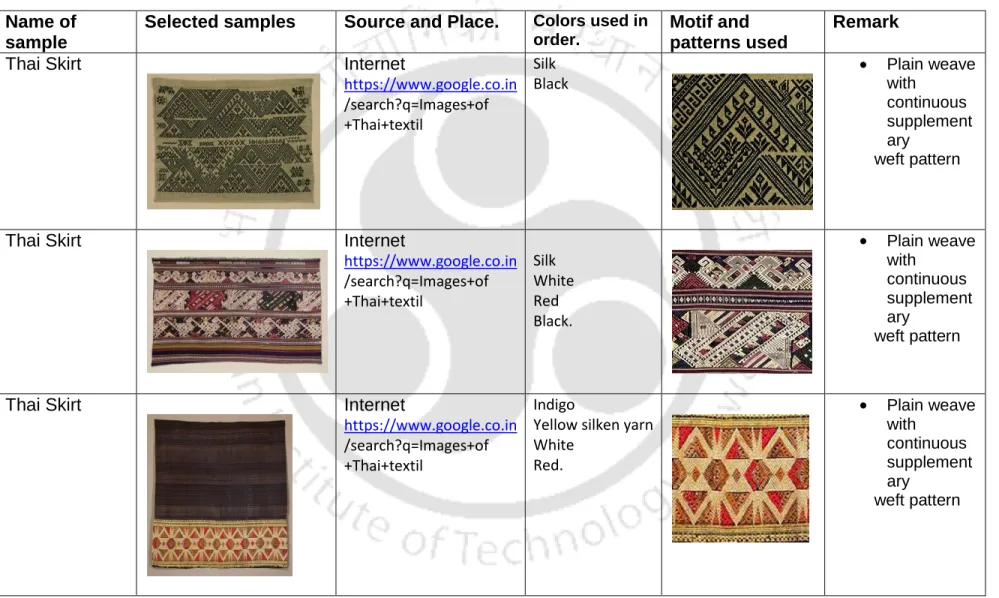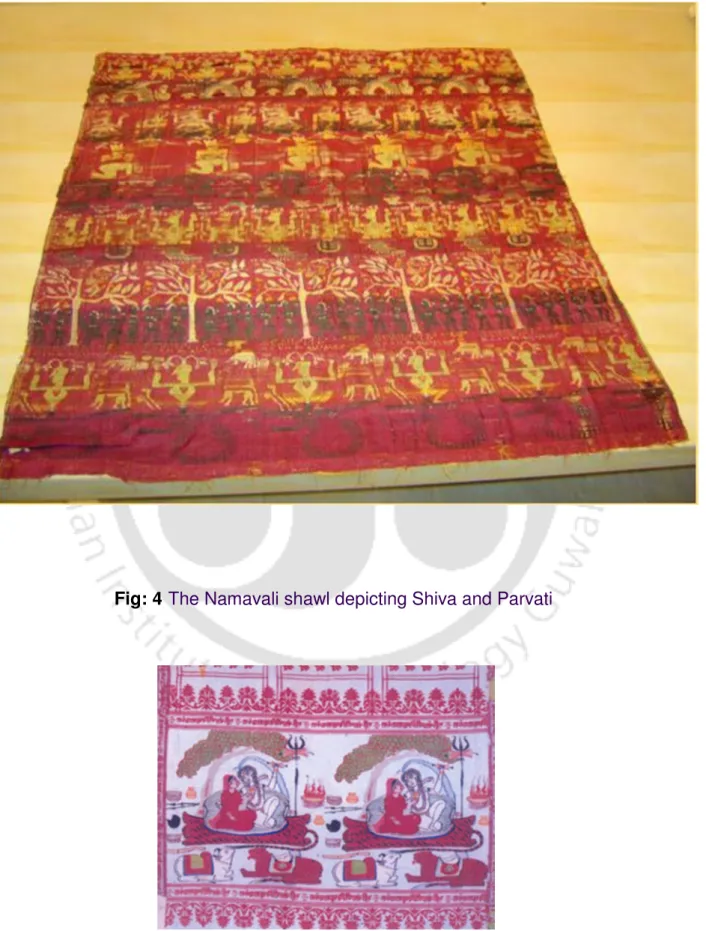The rich heritage of the Tais of Assam, so highly collective, is also in danger of dying out. Tai background, textile development and achievements 47-66 in Tai-Phake and Tai-Khamiyang fabrics.
Appendices
List of Tables
An analysis of textile patterns of the Tai-Phake and Tai-Khamiyang communities of Assam.

An Analysis of Textile designs of the Tai-Phake and Tai-Khamiyang Communities of Assam
CHAPTER- 1
- Introduction
- The Topic of the Research
- Textile design as a source of Identity
- Need for the study of Tai-Phake and Tai –Khamiyang Fabric Design
- Textile design of Assam in relation to India
This civilization and its culture were thus the sum of the primitive and the advanced. The total population of the ethnic groups is almost insignificant compared to the total population of the state and the country as a whole.
TEXTILE AND APPAREL SUPPLY CHAIN
CUSTOMISED RESEARCH SERVICE
IN TEXTILE
The data collected to an extent supports this view and finally it can be concluded that the modern designs of ethnic textile motifs have found a way into the hearts of all Assamese and have also been placed on the international platform. As an area for future research, the findings of this study will definitely shed light on how new designs can intervene for its applicability in Ethnic Fashion Technology - keeping the Northeast flavor intact while also ensuring it as an aid to the Government and Non-Governmental Organizations.
TEXTILES CLUSTERS IN INDIA
Priority of Textile Design in North East India and Assam
The northeastern part of India is blessed with diverse ethnic groups, most of whom migrate to this part of the country at different times, with each group intermingling with the existing communal cultures. The evolution of textiles in Northeast India must be equally emphasized for the variety of 'product forms' of fabrics that endure the traditional values of both the 'Aryans and the non-Aryans, and are the composite reflection in woven form of the existing multifarious anthropological traditions. museum.
Functional and Utilitarian value of the textile fabric in Assam
- The Vrindavani Vastra
A discussion of the history of Assam's textile tradition and the functionality and value of weaving techniques is incomplete without mentioning Vrindāvani Vastra (Brindābani Bastra). The work was undertaken at the request of the Koch king's brother Cilārāi, a very powerful commander of the Koch army.
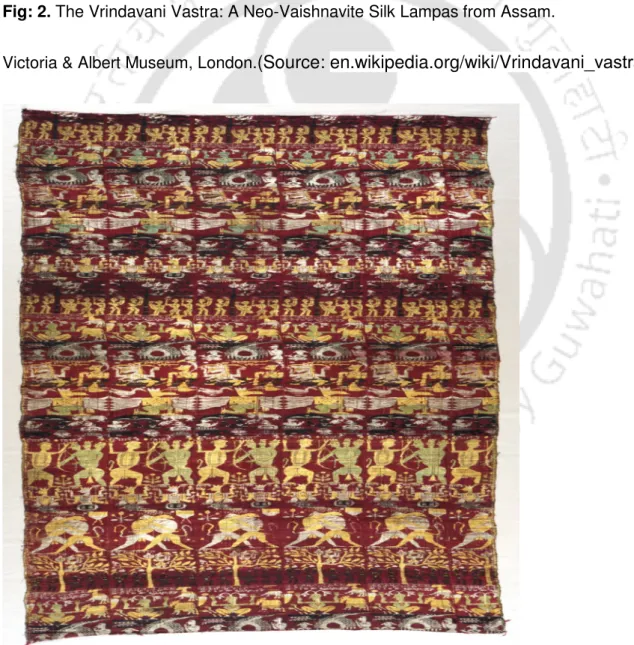
The communities of the North East India
Incentive for the study and that which focuses on textile of the Tai- Phake and Tai-Khamiyang
- Exchange and synthesis of the varied design elements and Techniques of weave between different ethnic groups of Assam
These two communities also emerged as the most popular but sparsely populated groups of the Tais in Assam, showing significant similarities with the Tais of Thailand and Southeast Asia. The field research also revealed another persistent problem faced by the ethnic weaver class: the yarn problem.
Sourcing the root of the design elements to Tai-culture in Assam
They belong to the Tai speaking tribal group living in parts of Upper Assam and Arunachal Pradesh. Equally prominent are the Khamiyangs, who also belong to the Tai-speaking group and cover parts of upper Assam.
Organizing of the color schemes
The Tai sub-clans like the Ahoms, Shyami, Khamti, Phake and Aitoni were people who migrated southwards in search of settlement and entered through the Patkai hills. Later, this natural dyeing of fabrics and clothes became a traditional technology of the Tai and Ahoms of Assam.
Semiotics in design: Study of the patterns
This often also necessitated and accelerated the need to dye cloth, especially the undergarment called "Mekhela" or "Chin". The organization of color schemes may seem bright and loud, but this choice was essentially due to people's attraction to the bright and basic colors found in their natural environment.
The Silk Industry in Assam
- Problem statement and present occupational Hazards
Once the weavers learn and become familiar with the process of chemically dyeing their yarns, perhaps the exposure to chemical hazards will be on the rise and that must also be a matter of concern to the entire social fabric. Even in agriculture and the tea industry, women make up the majority of workers and recently the exposure to pesticides for a quick and lush reproductive result exposes them to toxic substances, resulting in risks of health consequences, which are again constantly growing.
Justification for the study of the selected area
To quote him, "it becomes the responsibility of the designer to create conditions where they remain functional in relation to the modern atmosphere". Study has also shown that their population is decreasing throughout Asia and therefore a highly endangered culture altogether.
Eco-friendly natural Dye technology of the Tai’s in Assam
Dyeing natural fabrics is common in most Southeast Asian countries. Subsequently, natural dyeing of fabrics and clothes became a traditional technology of the Tai and Ahoms of Assam.
Motivation to the Thesis
Methodology and the flow of the work
Color preferences, pattern, vegetable dye, weaving technology and knowledge of thread processing from wild silkworm etc. Although the observations were participatory, most of the events and discussions were video-documented for future verification.
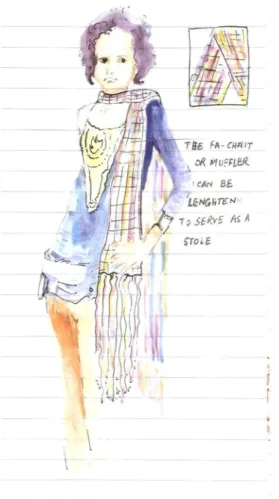
Hypothesis
Aim and objectives
To provide relevant ethnic based textile designs to Government and NGOs for the benefit of Indian Ethnic Fashion Industry. Although not relevant to the design factor, the study can be used as an argument to establish a link between the Tais of Assam and the Daic Phyla and Austronesia found in the rest of Southeast Asia and beyond.
Select plan for variable and information collection
The other popular material was the Eri yarn whose worm (Philosomia Ricini) fed on the leaves of the 'Ricinicus Communis L', while the. This necessitated and promoted the need for the color of the cloth, especially the lower garment called 'mekhela' in indigo colour.
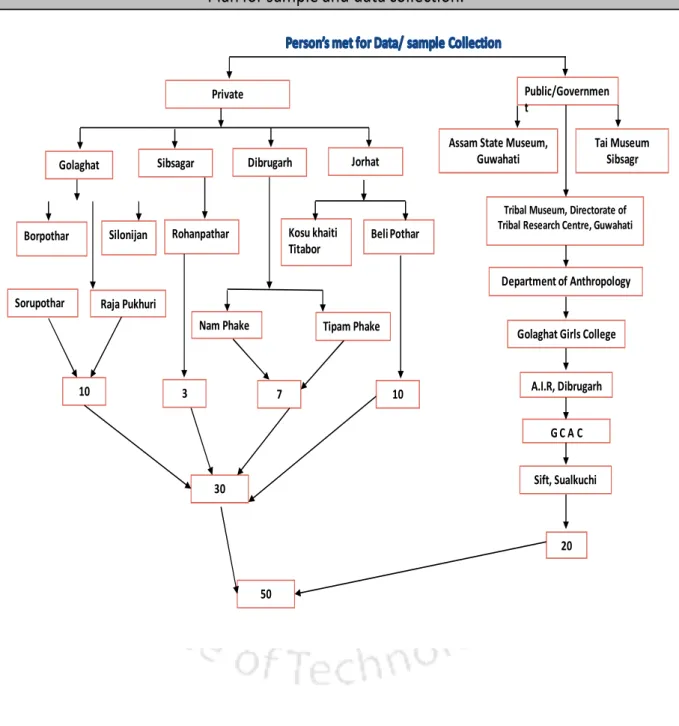
CHAPTER- 2 : Literature Review
Introduction
Among the innumerable artifacts produced in northeastern India, textiles are perhaps the only prominent commodity that is locally designed for mass production and that also bears the specific identity of the specific regions where it is produced. Although the issue of identity carriers was a possibility a few years earlier, it has become well established around the world in the 21st century.
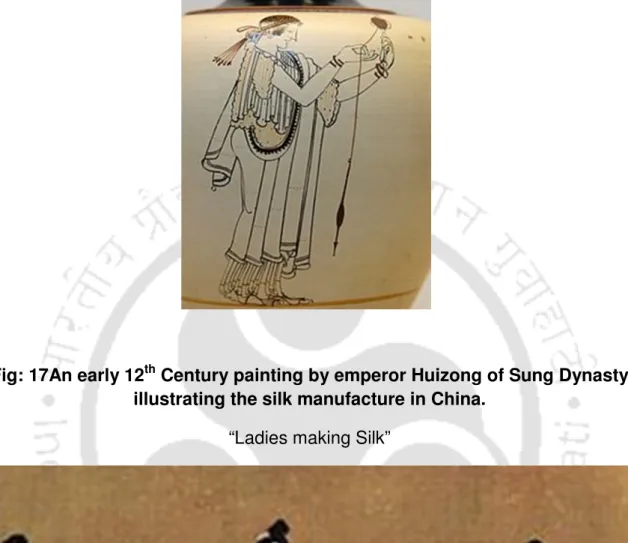
Textile - a desirable, luxurious human commodity
Therefore, the achievements of successful entrepreneurs like Borooah can be an inspiration to many textile entrepreneurs of Northeast India. Studying the traditional textiles of the world sometimes reveals an incredible variety of techniques and styles, while sometimes one can only wonder how cultures separated by vast distances have developed similar solutions to problems of design and construction.
Evolution of Textiles
Textiles stand next to agriculture as an income-generating activity for most of the rural population. The fabric's structure is as much a decisive factor for its functions as the choice of raw material.
Textile Industry of Assam
Silk in Assam is not a culture but a tradition, not a history but a way of life in the socio-economic structure of the society. The various stages in the processing of the silk yarn are mostly produced by hand. Stage -1 is locally called the 'Kathi Diya' where the mature female butterfly is attached to a straw stalk (ie, it is charmed) and it waits for its mate for mating.
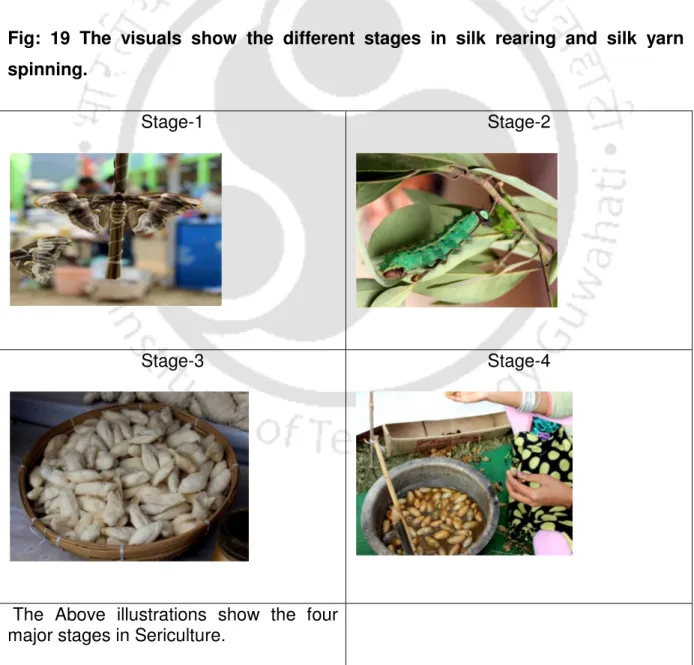
The Textile Design of the Thai’s
- The Language Phyla of the Tai’s. (A connection between Diac and Austronesaian languages)
- Importance of the Tai-Phake and Tai-Khamiyang communities
- The Tai-Phake Villages in Assam
- The Tai-Khamiyang Villages in Assam
The prehistory of the Daic (Tai-Kadai) speaking peoples and the hypothesis of an Austronesian connection, Blench, Roger, Kay William Educational Foundation, Cambridge, UK, 12 July 2009). Each household has a granary downstairs and the rest of the space is used by the women for weaving and dyeing activities.
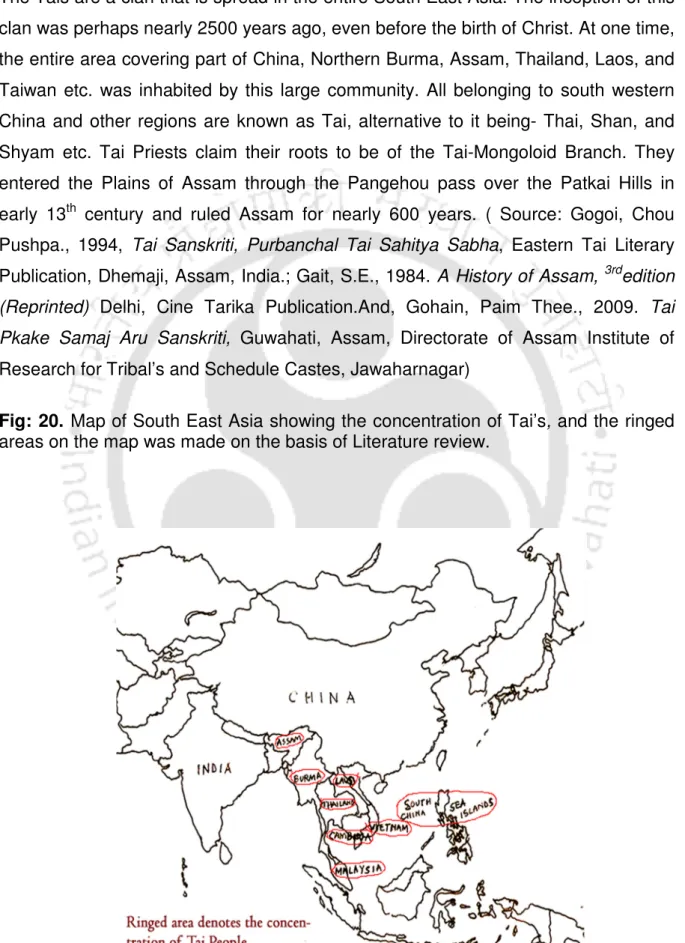
Demographic and statistical description of the community
From the charts above, we can see that the total population of the ethnic groups is almost negligible compared to the total population of the country and the country as a whole. Looking at the bar chart and pie charts, we can successfully negotiate that the current population of Tai – Khamiyang and tai phake ethnic groups in India is critically low.
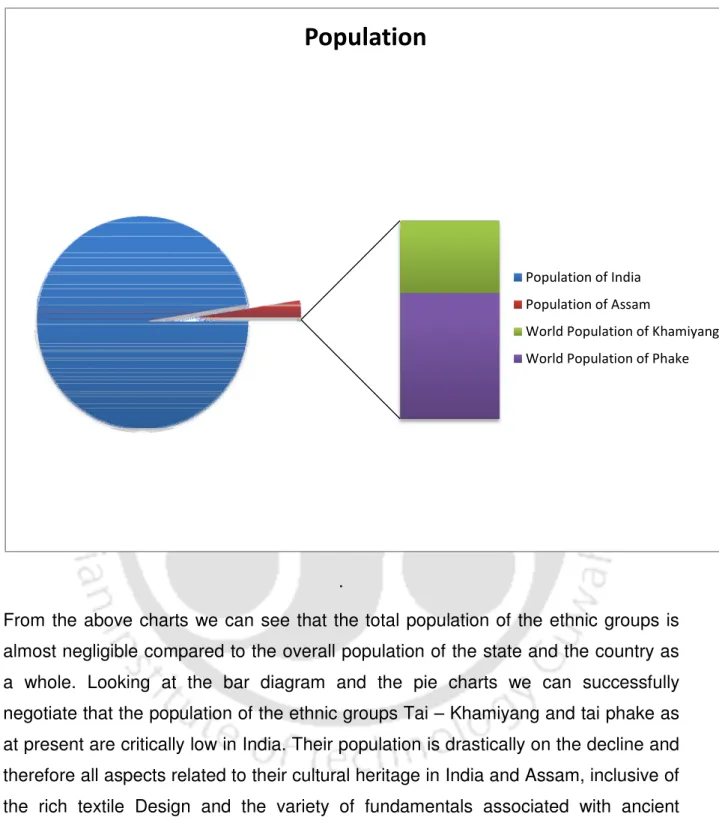
Conclusion
Study the findings in context to the body of work: Current situation of textiles of the Tai-Phake and Tai-Khamiyang and in relation to existing Socio-Ethno-Culture.
Introduction
Initiative of the State and Central Government towards asustainable textile Industry and its desired achievement
The Contemporary Textile and Fiber Art (TAFA) (Source: http//w.w.w tafalist.com and http//www en.wikipedia.org/wiki/Fiber_art) actually does any discussion on modern global ideas of conversion of traditional textile cultures and techniques in contemporary art seems ineffective, if it is not highlighted. Since the 1980s, fiberwork has become increasingly conceptual once influenced by postmodernist perception, often confronting cultural issues with gender feminism. (Source: http//w.w.w en.wikipedia.org/wiki/Fiber_art).
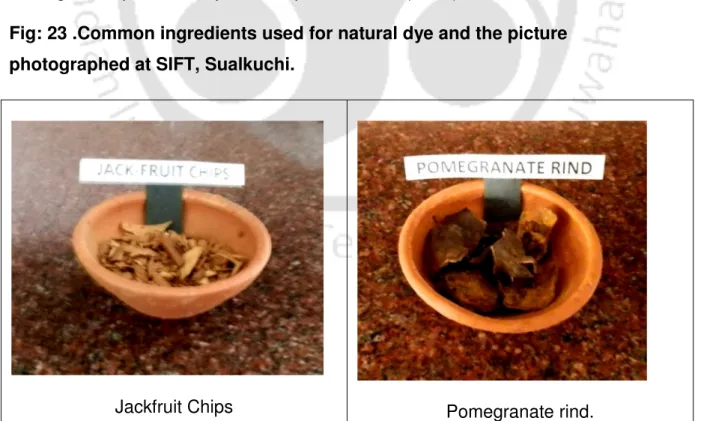
Statistical Analysis
- Gender and age of the respondents
- Literacy status of the respondents
- Marital Status of the respondents
- Size of family of the respondents
- Design related ratings and statistical analysis
- Experience in weaving of the respondents
- Preference of natural yarn and fiber by the respondents
Table: 8 (Below) shows the literacy percentage of the persons met during the study. The size of the families is small compared to other local communities of the Brahmaputra valley.
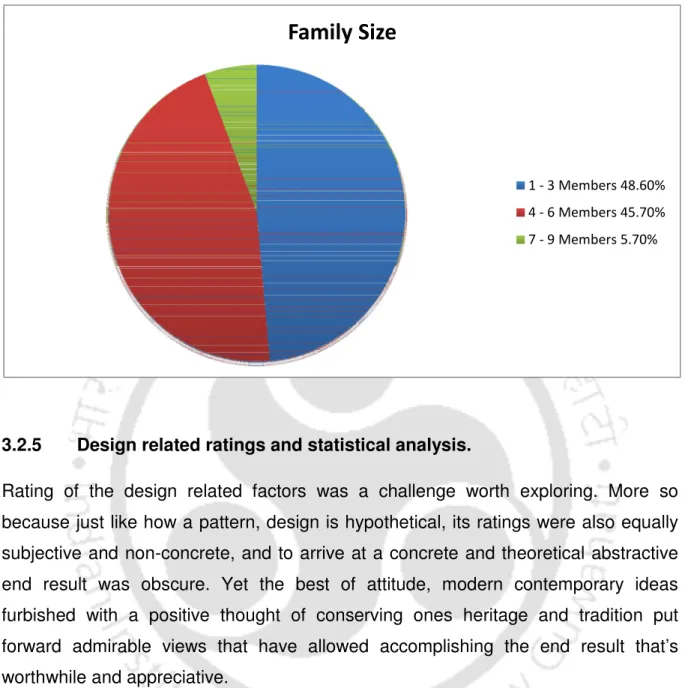
Other important particulars of the respondents
Sample and variable collection
Risk factor of extinction of Tai Textile
Earlier, most of the "Som" or "Antheraea Assamma" trees were grown in the tea gardens because it served two purposes. Gradually the priority was given to the tea industry and the haphazard use of pesticides for proper lush growth of the leaves hampered sericulture and became the main reason for the low silk productivity of silk cocoons.
Observation
- Vegetable Natural dye of the Tais of Assam
Assam Indigo begins flowering in mid-winter and should flower again in the spring. The industry's monopoly continued for a thousand years until some eggs were smuggled out of the country.
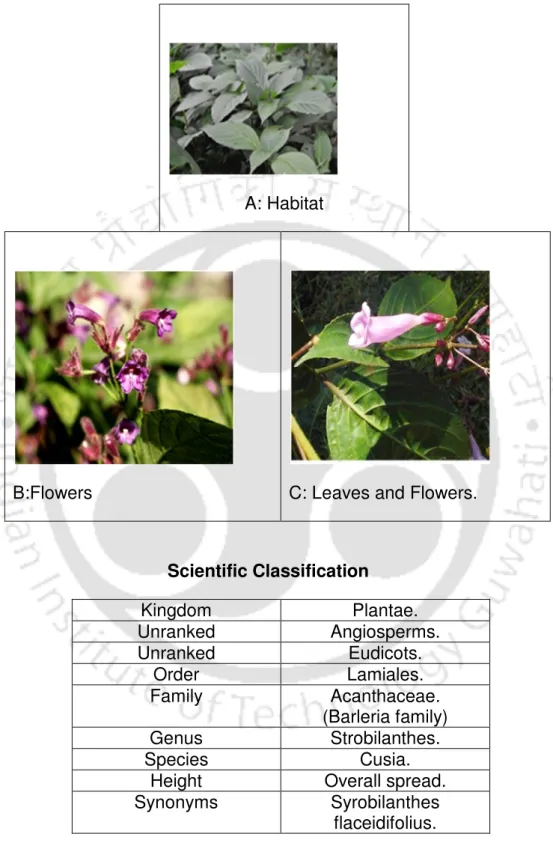
Results
It is therefore clear enough that the same also reached the Brahmaputra valley thanks to the Tais who were descended from the region of south-west China. One may also mention the shoulder wrap used by Muslim Sufi men, a tradition taken from Arab countries: the most appropriate example is the great 'Azan-peer', the legendary Sufi saint of Assam, who overwhelmingly wore such wrap.
The natural, organic dyeing activity- women specific
Final achievement of the fabrics of the Tai-Phake and Tai-Khamiyang
It is the continuous weave patterns and the tapestry weave is reflected in the Royal Ahom, Assamese and local ethnic textiles of the North East. It can be assumed that there is a strong connection between the textile pattern and designs of Tai Khamiyang and the Ahoms textile and fabrics.
Empirical assessment of variables and testing of the Hypothesis
- Visual findings and evaluation of the designs in relation to motif, pattern, form and colour
- Evaluation of the designs in relation to color
- The incorporation of Ceremonial stole designs and its evolution
- Identified similitude between Tai patterns and modern Mekhla fabric patterns
- Computer aided designs and its popularity and acceptance in present silk fabric Industry of Assam
- Comparison between the patterns of Thai Textile and the Khamti Textile
- Extracted Motifsof the Thai Textile and the Khamti Textile
- Case study of the Kingkhap design and examination of the evolution Over the hundreds of years, the Kingkhap motif has undergone several stages of
- Extracted motifs of Modern Contemporary Patterns from the traditional patterns
- Motifs created for tourists and modern consumer demand
It is a prominent pattern among both the hill dwellers and the local Assamese communities of the Brahmaputra Valley. This pattern is an adaptation of the Rabha motif of the 'Fan', which has been modified to resemble a flower with ten petals.
Chapter-4
Testing of the hypothesis
Negative and null hypothesis appeared in a few specific cases such as the use of dyes for cotton, which was only popular among the Tai-Phake people. Silk was favored by the Tais, but what the hypothesis could not assume was the popularity of the 'Eri' yarn as the much praised 'Ahimsa yarn'.
- Scope for contemporary use of motifs in modern everyday use
- Justification for the scope of design development of Tai textile
The unique aesthetic designs and patterns on the products are a blend of ethnicity, heritage and identity of the region of Assam. This is a continuous process which will require constant support from both private and public companies engaged in the development of the textile designs.
Prospect of acceptability by consumers
Most Tai clothing (for both Tai-Khamiyang and Tai-Phake) is woven on the back belt loom and arm loom. This is also how the set objectives will be met. The association of the Tai of Assam with the linguistic lineage of Diac and Austronesians has already found a connection with Thailand and Southeast Asia, which the Tai people are very committed to preserving.
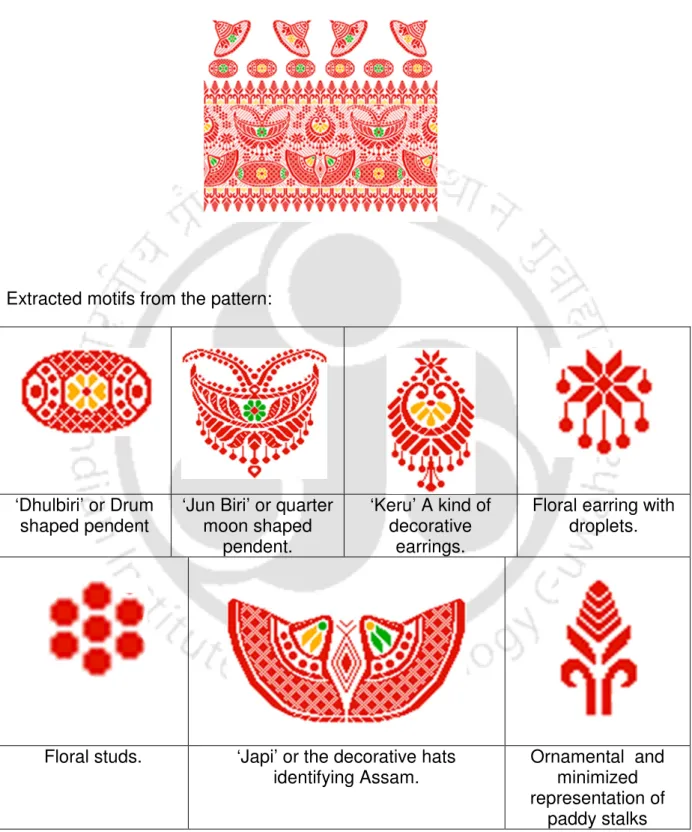
Suggestions and Recommendations
Note: The above table of model preferences is built on the basis of the ratings given by the personnel interviewed during the field study. A Study of the Silk Roads During the Later Han Dynasty, 1st to 2nd Centuries CE.
